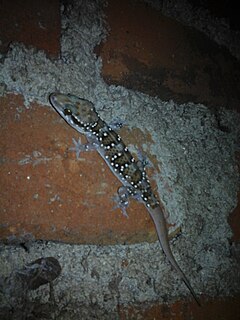
The Pholcidae are a family of araneomorph spiders. The family contains over 1,800 individual species of pholcids, including those commonly known as cellar spider, daddy long-legs spider, carpenter spider, daddy long-legger, vibrating spider, gyrating spider, long daddy, and skull spider. The family, first described by Carl Ludwig Koch in 1850, is divided into 94 genera.

The grey junglefowl, also known as Sonnerat's junglefowl, is one of the wild ancestors of the domestic chicken together with the red junglefowl and other junglefowls.

Poecilotheria is a genus of tarantulas native to India and Sri Lanka. It was first described by Eugène Louis Simon in 1885. They are arboreal tarantulas, commonly known as ornamental tarantulas, known for their vivid color patterns, fast movement, and potent venom compared to other tarantulas. As of 2019 all species are protected under CITES.
Wildlife of Sri Lanka includes its flora and fauna and their natural habitats. Sri Lanka has one of the highest rates of biological endemism in the world.
Nannophrys naeyakai, also known as the Sri Lanka tribal rock-frog or Sri Lanka tribal rock frog, is a species of frogs in the family Dicroglossidae. It was described as a new species in 2007. It is endemic to Sri Lanka, where it is only known from two localities in Ampara and Monaragala Districts. N. naeyakai can be distinguished from the other Nannophrys species by the details of the tubercles on the fourth toe, sharp and narrow symphysial knob on the anterior edge of mandible and small palmar tubercles. The specific name naeyakai refers to the "naeyaka", spirits of deceased relatives in the believes of Vedda people living in the type locality area.

Poecilotheria ornata, known as the fringed ornamental or ornate tiger spider, is a large arboreal tarantula, which is endemic to Sri Lanka. Their legspan sometimes reaches 10 inches (25 cm) in females, and is probably the second largest of the genus, behind Poecilotheria rufilata.

Hemidactylus lankae is a species of gecko endemic to island of Sri Lanka.

Panjange is a genus of leaf-dwelling spiders in the family Pholcidae, widely distributed in the islands of Southeast Asia from Borneo and the Philippines to northern Australia. Panjange spiders exhibit some of the most extraordinary morphology among Pholcidae. Males of most species have eye stalks, sometimes with long pointed processes; males of some species have unusually elongated pedipalps, which in spiders function as copulatory organs; and females of some species have external portions of their genitalia strongly folded and extensible. The biological significance of these sexual modifications remain unclear.
Belisana benjamini, is a species of spider of the genus Belisana. It is endemic to Sri Lanka.
Belisana keyti is a species of spider of the genus Belisana. It is endemic to Sri Lanka.
Belisana ratnapura is a species of spider of the genus Belisana. It is endemic to Sri Lanka.
Sihala ceylonicus, is a species of spider of the genus Sihala. It is known to be endemic to Sri Lanka, some suggest its presence in Malaysia as well.
Sihala is a genus of cellar spiders in the family Pholcidae, containing two species. The two species were once classified in the genus Pholcus, but were moved due to the absence of the characteristic sclerites shown in the bulb, and the unusually small and simple procursus.
Pholcus fragillimus, is a species of spider of the genus Pholcus. It is distributed from Sri Lanka, India to Japan. The type material of Pholcus fragillimus has probably been destroyed in Stuttgart during the Second World War, and only one female is available now in museums.
Tissahamia ethagala is a species of spider in the family Pholcidae. It is endemic to Sri Lanka.
Tissahamia maturata is a species of spider in the family Pholcidae. It is endemic to Sri Lanka.

Smeringopus pallidus, known as the pale daddy-long-leg, is a species of spider of the genus Smeringopus. It is a cosmopolitan species found in many countries.
Wanniyala hakgala is a species of spider of the genus Wanniyala. It is endemic to Sri Lanka. The species was described with a male found from Hakgala area, hence the specific name.
Wanniyala is a genus of cellar spiders native to Sri Lanka, first described by Huber & Benjamin in 2005. They have six eyes and four pair of legs and grow up to 2 mm in length. The abdomen is globular and males have a distinctive distal hinged sclerite on the procursus of genitalia. The name is derived from the Sri Lankans native to the island that the first spiders were found on- the Vedda people- and their surname Wanniyala-Aetto.

The Red-backed flameback, Lesser Sri Lanka flameback, Sri Lanka red-backed woodpecker or Ceylon red-backed woodpecker is a species of bird in the family Picidae. It is endemic to Sri Lanka, only absent in the far-north. It is sometimes considered a subspecies of the Black-rumped flameback.







